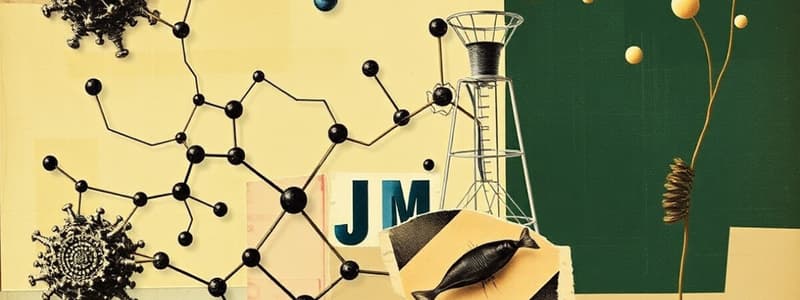Podcast
Questions and Answers
Why are lipids considered the best source of energy for the body?
Why are lipids considered the best source of energy for the body?
Lipids provide more energy per gram than carbohydrates or proteins.
What is the difference between saturated and unsaturated fats in terms of their chemical structure?
What is the difference between saturated and unsaturated fats in terms of their chemical structure?
Saturated fats contain only single bonds between carbon atoms in their fatty acid tails, while unsaturated fats contain at least one double bond.
Explain how the structure of a phospholipid contributes to the formation of cell membranes.
Explain how the structure of a phospholipid contributes to the formation of cell membranes.
The hydrophilic head of a phospholipid faces the watery environment inside and outside the cell, while the hydrophobic tails are repelled by water and form a barrier in the middle of the membrane.
Name two types of steroids and describe their functions.
Name two types of steroids and describe their functions.
What is the basic structure of an amino acid, and what makes one amino acid different from another?
What is the basic structure of an amino acid, and what makes one amino acid different from another?
What is the primary function of a protein? Give an example.
What is the primary function of a protein? Give an example.
Describe the process of protein formation, including the type of bond involved.
Describe the process of protein formation, including the type of bond involved.
Explain why the number of possible protein structures is virtually limitless.
Explain why the number of possible protein structures is virtually limitless.
What are the six main elements that make up macromolecules?
What are the six main elements that make up macromolecules?
Define dehydration synthesis and its role in forming macromolecules.
Define dehydration synthesis and its role in forming macromolecules.
What is hydrolysis and how does it differ from dehydration synthesis?
What is hydrolysis and how does it differ from dehydration synthesis?
Identify the two main types of carbohydrates and their subcategories.
Identify the two main types of carbohydrates and their subcategories.
What is the chemical formula for a monosaccharide and a disaccharide?
What is the chemical formula for a monosaccharide and a disaccharide?
Explain the significance of glycosidic bonds in carbohydrates.
Explain the significance of glycosidic bonds in carbohydrates.
How do the arrangements of the same chemical elements in macromolecules affect their properties?
How do the arrangements of the same chemical elements in macromolecules affect their properties?
What role do carbohydrates play in living organisms?
What role do carbohydrates play in living organisms?
Flashcards
Biochemistry
Biochemistry
The study of molecules that build and run living organisms.
Macromolecules
Macromolecules
Large molecules made of smaller units called monomers, forming polymers.
Monomers
Monomers
Small molecules that can join to form larger macromolecules.
Polymers
Polymers
Signup and view all the flashcards
Dehydration synthesis
Dehydration synthesis
Signup and view all the flashcards
Hydrolysis
Hydrolysis
Signup and view all the flashcards
Carbohydrates
Carbohydrates
Signup and view all the flashcards
Simple sugars
Simple sugars
Signup and view all the flashcards
Lipids
Lipids
Signup and view all the flashcards
Triglycerides
Triglycerides
Signup and view all the flashcards
Saturated fats
Saturated fats
Signup and view all the flashcards
Unsaturated fats
Unsaturated fats
Signup and view all the flashcards
Phospholipids
Phospholipids
Signup and view all the flashcards
Steroids
Steroids
Signup and view all the flashcards
Amino acids
Amino acids
Signup and view all the flashcards
Peptide bonds
Peptide bonds
Signup and view all the flashcards
Study Notes
Macromolecules
- Molecules are made of atoms
- Biochemistry studies molecules in living things
- Living things need many types of molecules, including proteins, carbohydrates, lipids, nucleic acids, vitamins, minerals, and hormones
- Macromolecules are mostly made of carbon, hydrogen, oxygen, nitrogen, phosphorus, and sulfur (CHONPS)
Macromolecules of Life
- Carbohydrates:
- Subunits: sugars (e.g., glucose), polymers of glucose
- Functions: energy storage
- Examples: sugars, starches, glycogen
- Lipids:
- Subunits: glycerol, fatty acids
- Functions: energy storage, cell membranes, hormones, vitamin carriers, insulation, cushioning
- Examples: fats, oils, phospholipids
- Proteins:
- Subunits: amino acids
- Functions: transport, blood clotting, support, immunity, catalysis, muscle action
- Examples: hemoglobin, fibrin, collagen, antibodies, enzymes, actin, myosin
- Nucleic acids:
- Subunits: nucleotides
- Functions: transfer and expression of genetic information
- Examples: DNA, RNA
Polymerization and Hydrolysis
- Macromolecules are assembled from smaller molecules called monomers
- Dehydration synthesis: monomers combine to form polymers, releasing a water molecule
- Hydrolysis: polymers break down into monomers, using a water molecule
- Monomer + Monomer = Polymer + H2O
Carbohydrates
- Simple sugars: Monosaccharides -single sugar units
- Examples: glucose, fructose, galactose
- Disaccharides -two sugar units
- Examples: maltose, sucrose, lactose
- Bond between monomers is called glycosidic bond
- Complex carbohydrates or polysaccharides - three or more sugar units
- Examples: starch, glycogen, cellulose
Lipids
- Insoluble in water
- Best source of energy, but not immediately usable
- Triglycerides: made of glycerol and fatty acid chains, important for energy storage
- Saturated fats: solid at room temperature, found in animal products
- Unsaturated fats: liquid at room temperature, found in plant products
- Phospholipids: have both hydrophilic (water-loving) and hydrophobic (water-fearing) parts, crucial for cell membranes
- Steroids: lipids with a ring structure, function in cell membranes and hormones
Proteins
- Amino acids are the building blocks of proteins
- Peptide bonds: link amino acids together
- Proteins have complex 3D shapes determined by amino acid sequence
- Denaturation: protein shape change (temporary); affected by heat, radiation, pH
- Coagulation: protein shape change (permanent)
Nucleic Acids
- Nucleic acids store and transmit genetic information
- DNA (deoxyribonucleic acid): double-stranded helix
- RNA (ribonucleic acid): single-stranded
- Nucleotide: monomers of nucleic acids. Consist of a sugar, phosphate group, and a nitrogenous base.
- The ordering of nitrogenous bases is the genetic code
Studying That Suits You
Use AI to generate personalized quizzes and flashcards to suit your learning preferences.




